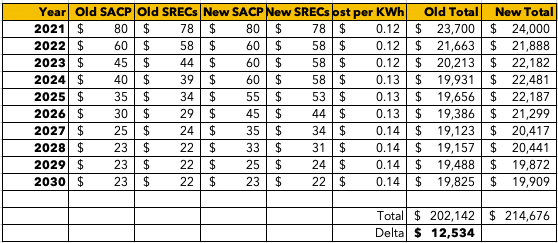As readers of the blog know, there are several key factors that explain the price of SRECs (Solar Renewable Energy Credits). One of these factors is the Solar Alternative Compliance Payment (SACP). The SACP is the fee that energy retailers (like Pepco and Constellation) must pay if they can’t meet their Renewable Energy Portfolio Standard (RPS).
They can avoid paying the ACP by instead purchasing SRECs that are generated by solar PV system owners. As such, the ACP and SRECs are positively correlated; the higher the ACP, the more valuable the SRECs will be. And the value of SRECs will always be lower than the ACP, or it would be easier for the energy producers to simply pay the ACP in lieu of buying SRECs.
In summary: The RPS is enforced with the ACP, which can be be avoided by purchasing SRECs.
On May 30th, 2021 The Maryland Legislature passed Maryland Senate Bill 65, which raised the SACP over the years from 2023 to 2029 per the chart below.
So how will raising the SACP likely affect PV system owners in the Free State of Maryland? Currently, MD SRECs are trading at $77/MWh based on a SACP of $100. Let’s posit that this ratio holds for the next 10 years with a hypothetical 100 kW (kilowatt) solar array that produces 120,000 kWh/year. Here’s the cash flow comparison between the previous (old) SACP and the newly enshrined SACP:
As a result of this legislation, this same array will produce an additional $12,534. Not too shabby, but still a far cry from the generous DC SRECs, which currently sit at $390/MWh.
Combining this development with relatively high retail electric rates, we are seeing additional opportunities open up for third party owned commercial solar energy systems, particularly on arrays larger than 300 kW and garden style multifamily communities.


